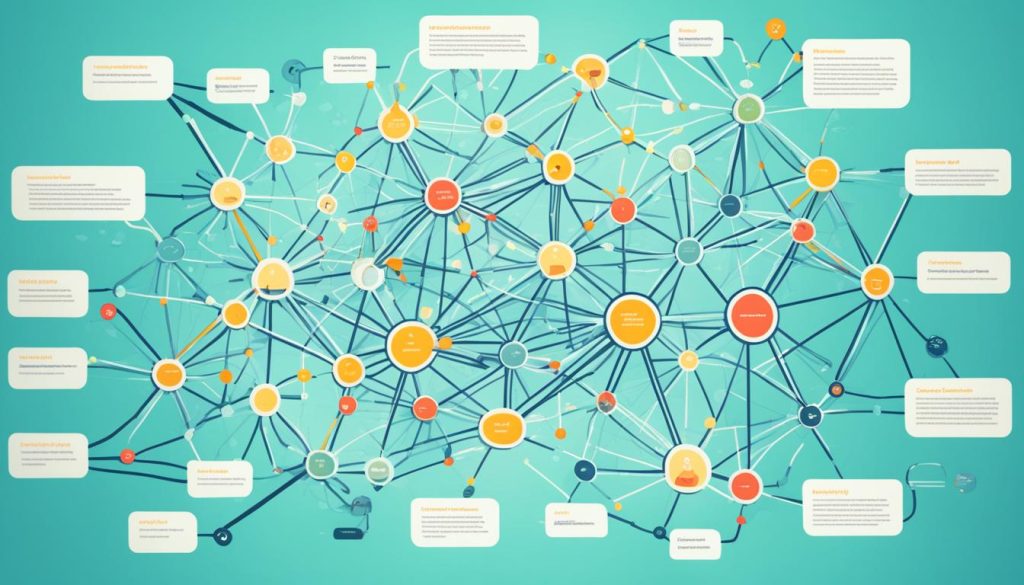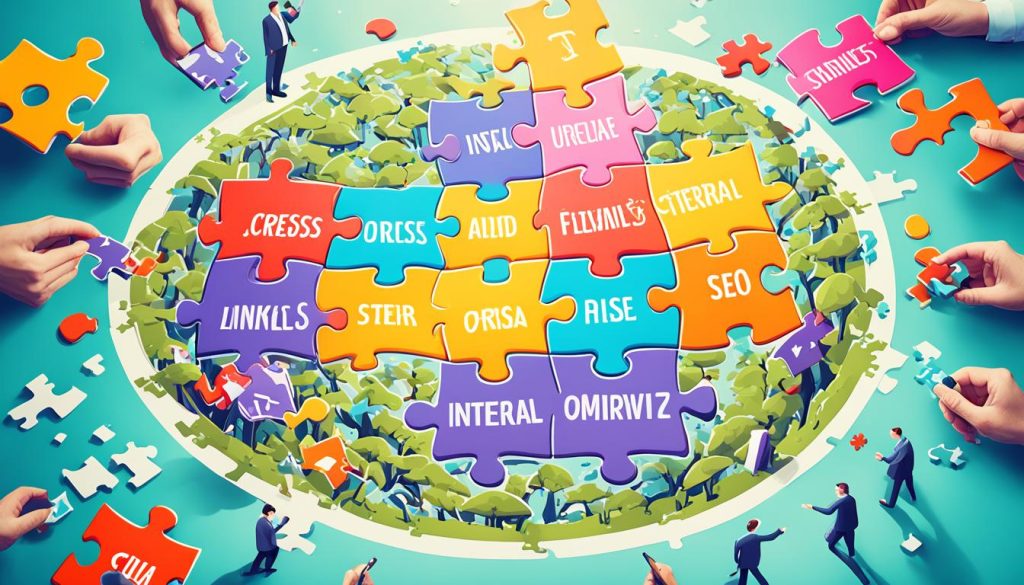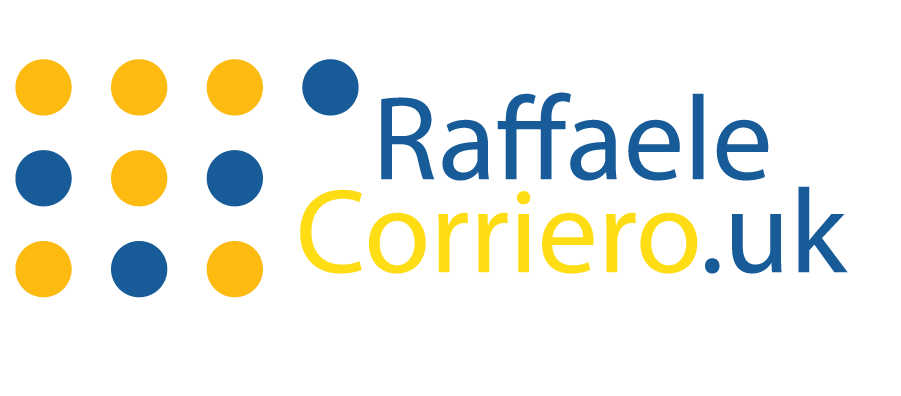Internal links play a key role in improving a website’s visibility and rank in search engines. They help search engine algorithms understand and index a site more effectively. Thanks to AI, we can now link pages more wisely to enhance user experience. This reduces bounce rates and keeps visitors on the site longer. Also, AI’s role in internal linking focuses on the quality and relevance of links. This shift has made topic clusters and pillar pages vital. They help show a site’s expertise and boost its presence in related searches.
Key Takeaways
- AI-powered SEO enhances the relevance and quality of internal links.
- Well-placed internal links can reduce bounce rates and increase user engagement.
- Search engine rankings improve with optimally structured internal links.
- Utilising internal linking automation can streamline link-building strategies.
- The use of AI in internal linking strengthens website optimisation processes.
The Importance of Internal Links in the Generative AI Era
The generative AI era greatly boosts internal links’ importance for SEO. With AI-enhanced search engine algorithms, the relevance of linked content is clearer. These links show search engines what topics a website knows well. This is especially key for e-commerce sites with lots of content.
The impact of Generative AI goes beyond just site layout. It aims to make browsing personalized and more relevant for users. By understanding content links better, AI can improve how users navigate. This boosts user happiness and keeps them engaged. So, internal links are crucial for SEO in the AI era, urging firms to update their linking plans.
Why Big Websites and E-Commerce Platforms Should Care About SEO Internal Linking
For big websites and e-commerce platforms, internal linking is key to good SEO. It makes navigating the website easier, helping customers find what they need quickly. These links boost customer engagement by making the journey better.
The Role of Internal Links in Site Navigation
Internal links help structure a site well, guiding users smoothly through it. They’re key for e-commerce sites, helping users find products fast. This improves the chance of making a sale. They also keep the site easy to use, leading to more visits and longer stays.
Enhancing User Experience with Internal Links
Internal linking does more than improve navigation; it also makes the user experience better. Placing links wisely in content directs users to what they’re looking for. This approach makes users feel supported and not overwhelmed. Each click gets them closer to what they need, making their journey satisfying.
AI and Internal Links to Boost SEO

Integrating AI into SEO has changed how we link internally. With AI, finding and using internal links has become more precise. This improves how effectively websites use internal linking.
AI’s Role in Identifying Relevant Internal Links
AI is great at finding the right internal links. It looks through lots of data to link parts of a website smartly. This makes sure each link adds value to the site’s content.
Optimising Internal Links for Enhanced SEO Performance
AI tools help automate creating internal links, saving lots of time. They ensure every link is consistent and follows SEO rules. This leads to better search engine rankings.
Real-World Examples of AI-Driven Internal Linking
Many companies now use AI to improve their internal links. It has made website navigation smoother and content easier to find. Using AI makes internal linking and SEO work better together.
Internal Linking Strategies for E-Commerce Product Pages
Improving e-commerce product optimisation starts with good internal linking. Organising product categories and linking related items make shopping better. This boosts the shopping experience vastly.
Organising Product Categories and Subcategories
It’s crucial to organise product categories well. A strong link system between categories helps users find what they need easily. This makes shoppers happy and boosts your site’s SEO, drawing more attention from search engines.
Improving Product Discoverability
Making products easy to find is key to increasing sales. Links in product descriptions, categories, and blogs guide users to related items. Such linking connects the shopper’s journey, improving product pages’ visibility.
Cross-Linking Related Products for Better Conversion Rates
Linking related products can boost sales. By connecting complimentary items, you can suggest additional buys. This enhances customer interaction and optimisation, showing more products in one go and bettering page metrics.
Combining Dynamic Internal Links and Schema Markup for Increased SEO Revenue
Using dynamic internal links with schema markup boosts your site’s SEO revenue. It helps search engines find and rank your important pages higher. This increases your site’s visibility.
Using SignificantLink Schema Markup Property
The SignificantLink schema property highlights key category pages. It guides search engines to these vital spots, improving your content’s SEO strength. This focus raises the value of your most important pages.
Implementing RelatedLink Schema Markup Property
Adding the RelatedLink schema property links your content smartly. It makes your site’s structure clearer and connects related items and articles. This not only boosts SEO but also helps users navigate your site better, making important content easy to find.
Best Practices for Implementing Dynamic Internal Links

Using dynamic internal links wisely boosts your site’s SEO. It’s all about being strategic to get the best out of your website. Adopting these methods improves how search engines see and index your site.
Creating a Logical Website Structure
It’s key to have a clear structure for your website. This makes it easier for search engines to navigate and understand your site. It boosts your site’s visibility online.
Using Keyword-Rich Anchor Texts
Choosing the right anchor texts is crucial. They should be rich in keywords and relevant to the page they link to. This enhances your site’s SEO and makes your links more effective.
Maintaining Descriptive Labels for Navigation Menus
Navigation menus should have clear, descriptive labels. This helps users get where they want to go on your site. Keep these labels up to date to keep your site easy to use.
Leveraging Leaked Google Documents for Internal Linking Strategies
Looking into leaked Google documents gives us great Google SEO insights. It helps in planning better internal linking. These documents show how Google views internal links. This is key for refining your linking methods. Knowing how Google’s algorithms see link structures helps SEO experts. They can then create more precise SEO strategies.
These documents clear up how internal links affect search engine rankings and site trust. By using this knowledge, we can make internal linking better to boost site performance. It’s about placing strategic internal links to guide search engines properly. This makes sure important pages are seen.
Also, this knowledge helps in building content clusters that meet Google’s criteria. By applying these strategies, your website layout meets what search engines look for. This improves user experience and raises rankings. In the end, these special Google SEO insights help us. We can make smarter SEO strategies for stronger internal linking.
Key Findings from Google’s Internal Documents
Looking into Google’s internal documents, we learn a lot about SEO. They shed light on Google’s ranking factors, changing how we view search engine optimisation. They show how vital internal linking is for search rankings.
The analysis of these documents reveals how search algorithms sort and highlight content. This is key for SEO professionals to improve their tactics. Google’s guidelines stress the need for a well-linked site for easy navigation by users and search engines.
From these documents, we learn the importance of internal links in making a site more relevant and authoritative. This pushes SEO experts to tweak their strategies to fit Google’s ranking factors better.
This insight emphasises the role of internal links in SEO success. Google’s documents guide us to better internal linking strategies. They show the importance of spreading link power throughout a site, mirroring how search engines value and prioritise content.
Actionable SEO Recommendations from Google’s Insights on Internal Links

Harnessing Google’s insights can vastly improve your website’s SEO. These SEO actionable insights aim to boost your site’s authority. They also make your content more relevant.
Start by making your internal links logical and relevant. Google advises that your linking patterns should meet user needs and please search engines. Focus on links that improve navigation and link to related content.
Next, build a solid link strategy with detailed keyword research. Including relevant keywords in your links can help raise your search rankings. Always aim for consistency and relevance in your link-building strategies.
Finally, keep an eye on your links by auditing them often. Google believes that tracking link performance is crucial. By updating your links, your site stays well-indexed and maintains high quality.
Maximising Crawl Budget through Effective Internal Linking
Managing internal links well is key to using your crawl budget wisely. By placing internal links smartly, you guide search engines to focus on your most important pages. This boosts your SEO indexing strategy.
Each internal link plays a role in using your crawl budget. Being smart about how you link pages helps search engines understand your site better. This is especially important for big websites and e-commerce sites. Here, the way you manage your crawl budget can really affect your SEO success.
To have a strong SEO indexing strategy, you need good internal linking. Your links should match your site’s structure and content goals. This helps search engines find and index your main pages that drive revenue. By improving how you manage your links, you also make your site easier for people to use.
It’s a good idea to regularly check and update how you link your pages internally. This keeps your links working well by making sure they’re relevant and make sense. It helps search engines work better on your site, focusing on the most important parts.
In the end, managing your internal links well is crucial for making the most of your crawl budget. This has a big impact on your SEO success. Use these strategies to highlight your key content for both website visitors and search engines.
Reducing Bounce Rates with Smart Internal Linking
Lowering bounce rates is all about clever internal linking. It’s based on knowing how users behave and linking relevantly. By doing this, users are happier, and search engines see your site as more valuable. This improves how well your site does in search engine rankings.
Analysing User Behaviour for Better Linking
Studying how visitors use your site is key for good links. It helps to see what they like. This way, you can add links that meet their needs.
Look at metrics like page views and click-through rates. These details can help you lead users smoothly through your site. This method can greatly lower your bounce rate.
Creating Contextually Relevant Links
For internal linking to work, links must be relevant to the content. They should add value and answer questions. For example, if a reader is looking into digital marketing, links to SEO or social media tips are useful.
These relevant links make users stay on your site longer. This not only drops bounce rates but also helps your site’s SEO.
Utilising AI to Personalise Internal Linking Strategies

AI technology has changed how we set up internal links, making them suit each user’s actions and likes. This smart method makes sure people see content that matters to them. This boosts interest and helps with SEO.
Using AI in SEO, websites can change links based on what users do right now. This improves how users feel on a site and helps search engines work better. It does this by showing links that fit what the user is looking for.
AI makes the journey through a website smarter. It takes users from one article to the next smoothly. This cuts down on people leaving the site too quickly and makes the site perform better. AI learns and changes, keeping the linking strategy good as user habits shift.
Adding AI to your SEO methods is crucial in the online world today. As AI gets better, we’ll see even smarter ways to link content. This will open more chances to make websites more engaging and SEO-friendly.
The Role of Neural Networks in Internal Link Generation
In the SEO world, neural networks are changing how we create internal links. They bring both efficiency and accuracy. This top-notch AI-enhanced SEO tech makes linking automatic but keeps it relevant within a site’s design.
With neural networks, webmasters automate creating links between related content. This not only improves the user’s experience but boosts SEO. It helps search engines find and list important pages easily.
Neural networks for SEO understand context to link smartly. They make sure links are placed to enhance content relevance and flow.
The future looks bright for AI-enhanced SEO in internal linking. Moving to automated link generation reduces mistakes and saves time. It also keeps the website well-organized and user-friendly.
Using neural networks for internal links is revolutionary. It brings unmatched ease and accuracy to SEO efforts, making optimization stronger and more effective.
Monitoring and Optimising Internal Links for Long-Term SEO Success
To keep your SEO strategy winning, you need to keep an eye on and tweak your internal links. By analysing link performance and changing things based on what users do, your site can lead in searches and user happiness.
Regular Link Performance Evaluation
Checking how your internal links do is key. With thorough SEO monitoring, you find out which links pull in visits and which ones don’t. This way, you make sure all your links work well for your SEO goals.
Continuous Adaptation Based on User Feedback
Changing your link strategy based on what users say is crucial for better SEO. Listening to your audience lets you tweak your site to fit their needs and likes better. This user feedback adaptation keeps your site easy to use and helps with SEO.
By mixing link performance analysis, SEO monitoring, and user feedback adaptation, your internal links can be perfect. This ongoing and proactive manner keeps your site at its best in the busy online world.
Future Trends: AI and Internal Linking in SEO
The SEO landscape is changing fast, with AI taking a big role. AI helps craft smarter internal linking strategies. This means users and search engines will have a better time navigating sites. AI is blending with SEO to automate linking on big, complex sites.
Personalising internal links with AI is becoming key. This tech studies how users behave and what they like. It then changes links for each visitor, making content more relevant and boosting SEO.
Another emerging trend is predictive SEO. AI can now predict and fix linking issues before they show up in data. This proactive method keeps websites ahead in the digital game. As AI evolves, focusing on users remains essential for top SEO performance.







